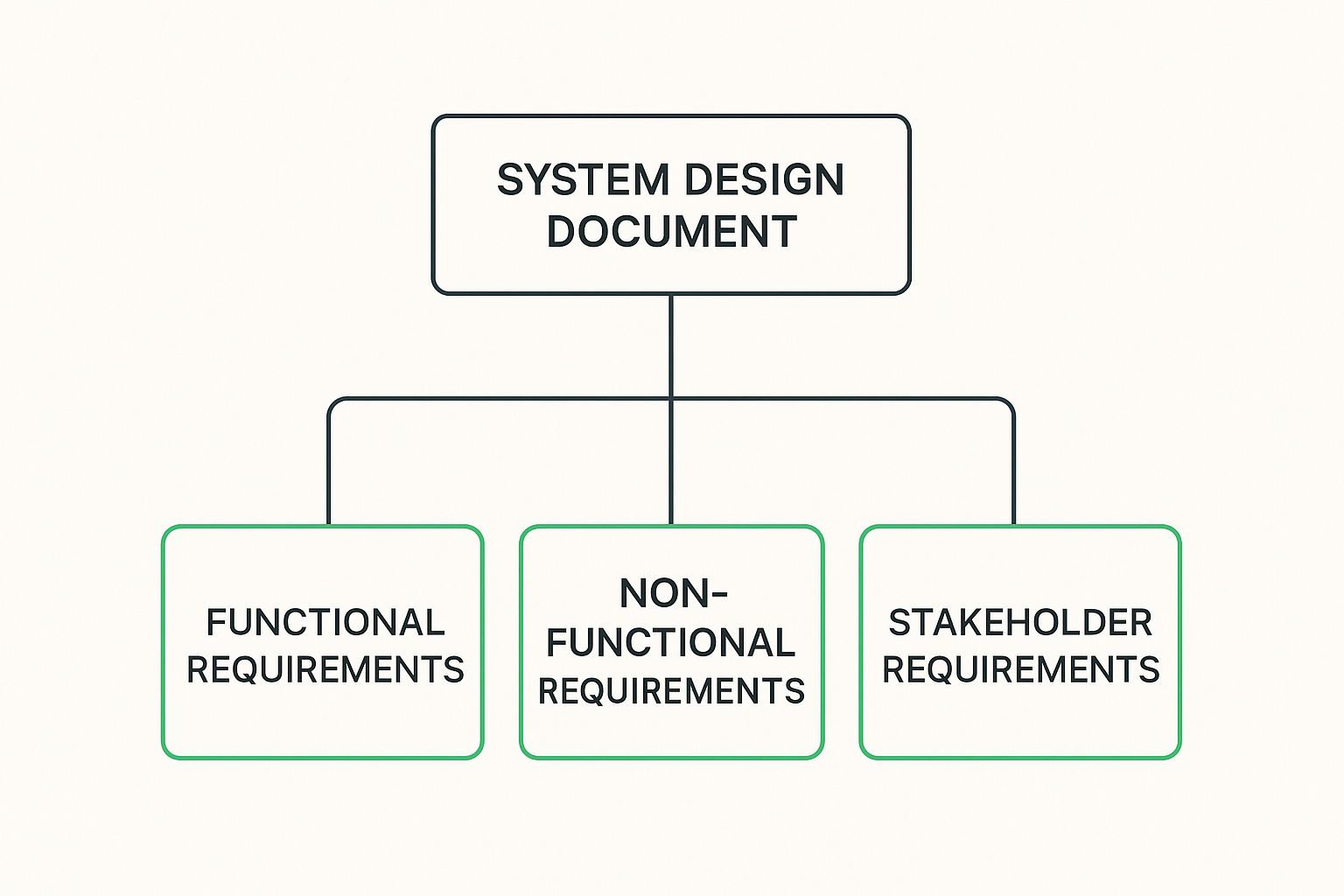Create a clear and effective system design document with our step-by-step guide. Learn to align teams and build robust software with proven best practices.
Think of a system design document (SDD) as the architectural blueprint for your entire software project. It’s the ultimate roadmap that guides development, launch, and even long-term maintenance. In short, it’s the single source of truth that gets engineers, product managers, and business leaders all on the same page.
By creating this plan upfront, teams sidestep major risks before anyone writes a single line of code.

Could you imagine building a skyscraper without a detailed architectural plan? The electricians wouldn’t know where to run wires, plumbers would be guessing at pipe layouts, and the whole structural strategy would be a mess. The result? A chaotic, unsafe, and incredibly expensive failure.
A software project is no different. Its complexity demands a clear, universally understood guide, and the system design document serves exactly that purpose. It translates abstract business goals into a concrete technical strategy, forcing everyone to think through critical decisions early—like choosing the right database, defining API contracts, and planning for future growth.
Without a formal SDD, project details get scattered across meeting notes, Slack channels, or locked away in the minds of a few key developers. This is a recipe for misinterpretation and knowledge silos.
A well-structured SDD cuts through that ambiguity. It acts as a central hub of knowledge, ensuring every team member—from a brand new junior dev to the CTO—shares the same understanding of the system’s architecture and goals. This shared context is what makes efficient collaboration possible.
Finding an architectural flaw after development is underway leads to expensive rework and frustrating delays. The SDD is your best tool for proactive risk mitigation.
By outlining the system’s structure, data flows, and dependencies from the start, teams can spot potential bottlenecks, security vulnerabilities, and scalability issues before they’re baked into the codebase. This initial planning phase is absolutely crucial for long-term success. To really nail these fundamentals, it’s worth digging into frameworks like the AWS Well-Architected Framework.
The process itself encourages a more deliberate and thoughtful approach to building software. The growing reliance on this kind of structured planning is clear from market trends. The global document management system (DMS) market, which includes tools for managing records like the system design document, was valued at roughly USD 7.68 billion in 2024. That figure is projected to more than double, hitting USD 18.17 billion by 2030.
Ultimately, investing time in a solid system design document pays for itself many times over throughout the project, leading to a more robust, maintainable, and successful product.
Let’s break down the core advantages into a simple table.
Having this document in place ensures that your project starts on a solid foundation, saving countless hours and headaches down the road.
A truly effective system design document is more than just a checklist; it tells the complete, cohesive story of the system you’re building. Think of it less like a list of parts and more like an assembly manual where every component logically connects to the next. This narrative approach builds a comprehensive picture for anyone involved in the project.
Breaking the system down into distinct, well-defined components is what makes the document truly actionable. Without this structure, an SDD can quickly become a dense, unreadable wall of text that fails to guide anyone effectively.
The hierarchy diagram below shows how an SDD organizes all the different project needs into one clear plan.

This visual makes it clear how an SDD serves as the central hub, translating high-level stakeholder goals into the specific functional and non-functional requirements that engineers will build.
To get this right, your SDD needs to include a few critical sections. Each one builds on the last, creating a complete and practical blueprint for development.
Here’s a quick look at the essential components and what they’re meant to accomplish.
Each of these sections plays a vital role in preventing misunderstandings and aligning the entire team on the path forward. Let’s dig into what makes each one so important.
This is the high-level map of your entire system. The architecture section uses diagrams and clear descriptions to show how all the different parts fit and work together. This is where you make the big-picture decisions, like choosing between a monolithic or a microservices architecture. It’s the blueprint.
This component isn’t just for architects; it provides a shared visual language for the whole team. Diagrams like UML sequence or component diagrams are invaluable here because they make complex interactions easy to grasp at a glance. If you’re looking to sharpen your diagramming skills, our guide on how to create a UML diagram is a great place to start.
A solid architectural overview ensures every developer understands exactly how their piece of the puzzle contributes to the whole, which helps prevent siloed work and nasty integration surprises later on.
If architecture is the skeleton, then data design is the circulatory system. This part of the SDD details how information flows, where it’s stored, and how it’s structured. It covers everything from database schemas and data models to the nitty-gritty of how data is created, read, updated, and deleted (CRUD).
Key elements of a strong data design section include:
This section is absolutely critical for maintaining data integrity and consistency. Without a well-planned data design, you’re just asking for an inefficient system that’s difficult to query and prone to corruption.
Modern systems almost never work in isolation. They talk to other services through Application Programming Interfaces (APIs). The API design section acts as a formal contract, defining precisely how different parts of your system—or external systems—will interact.
This “contract” must be completely unambiguous. It needs to specify every single endpoint, the expected request formats (including parameters and headers), and the exact structure of the responses, right down to the status codes and error messages. Tools like Swagger or OpenAPI are perfect for this, as they can generate interactive API documentation directly from these definitions.
A strong API design also enables parallel development. With a clear contract in place, a front-end team can build against a mocked API based on the SDD’s specs, while the back-end team gets to work on implementing the actual logic.
A system that works perfectly for 100 users might completely fall over with 100,000. The scalability and performance section tackles this challenge head-on. It defines clear, measurable goals for how the system must perform under load and exactly how it will scale to meet future demand.
This part of the document needs to answer a few key questions:
Thinking about these factors early on prevents the need for frantic, expensive re-architecting right when your user base starts to take off.
In a world of constant cyber threats and strict data privacy regulations, security can’t be an afterthought—it has to be baked in from day one. This section outlines all the measures you’re taking to protect the system and its data from unauthorized access, breaches, and other vulnerabilities.
This section needs to be comprehensive. It should cover everything from authentication and authorization mechanisms (like OAuth 2.0 or JWT) to data encryption standards, both at rest and in transit. If your system has to comply with regulations like GDPR or HIPAA, this is where you detail the strategy, ensuring every requirement is met from the ground up.
Ultimately, building trust with your users starts with a system that is provably secure and compliant.

Staring at a blank page for a system design document can feel totally overwhelming. But if you break the whole thing down into smaller, more manageable steps, it transforms from a monster task into a structured, collaborative process. The goal isn’t perfection on the first try; it’s about building a solid foundation you can refine as you go.
Think of it like putting together a piece of complex furniture. You wouldn’t just start screwing pieces together at random. You’d lay everything out, check the parts list, and read the instructions. That same methodical approach is exactly what you need to build a stable, functional system.
Before you can even think about designing a system, you have to know what it’s supposed to do. This first phase is all about investigation and getting everyone on the same page. You’ll be talking to product managers, business analysts, and even end-users to capture the full picture of both functional and non-functional needs.
Don’t just make a list of features. You need to dig deeper and understand the why behind every request. That context is absolutely critical for making smart architectural decisions down the road.
Key activities here usually involve:
Getting this foundational work right ensures the system you build is the one the business actually needs. To see how these requirements come together in a real-world document, checking out a solid system design document example can make things click.
Once you have a clear set of requirements, you can start sketching out the big picture. This is the high-level design (HLD)—the architectural blueprint for your entire system. It’s where you make the big, fundamental decisions that will guide the rest of the project.
Now is not the time to get lost in the weeds of specific implementation details. Instead, focus on the major components and how they’ll talk to each other. For example, is this going to be a single, massive monolith, or will it be a collection of smaller, independent microservices? That’s a core choice you make at this stage.
Your HLD should absolutely include diagrams to visualize the system’s structure. These can be simple block diagrams or something more formal, but the goal is the same: give everyone an easy-to-understand overview of the architecture.
After the high-level architecture gets the green light, it’s time to zoom in. The low-level design (LLD) is where you flesh out the details for every single component you mapped out in the HLD. This is where abstract ideas become concrete, actionable plans for the development team.
This section gets into the real nitty-gritty, spelling out exactly how each piece of the system will work. It’s the detailed instruction manual your engineers will use to actually write the code.
Important parts of the low-level design include:
This detailed work is what gets rid of ambiguity and makes sure every developer is building their piece of the puzzle in a way that will fit perfectly with everyone else’s.
A system design document should never be written in a silo. The final, and arguably most important, step is to treat it as a living document. Share the draft with your entire engineering team, product managers, and other key stakeholders.
Actively ask for feedback and be ready to make changes. A fresh set of eyes can often spot a potential bottleneck or an overlooked requirement you might have missed. This feedback loop is what makes the document truly battle-tested.
This review process shouldn’t be a one-time thing. As the system gets built and new challenges pop up, the SDD needs to be updated to reflect the current reality of the architecture. This keeps it from becoming an outdated relic and ensures it remains a valuable resource for the entire life of the project.
A system design document that gathers digital dust on a forgotten server is worse than having no document at all. Outdated information misleads developers, complicates onboarding, and kills trust in the very blueprint meant to guide the project. The only way forward is to stop treating documentation as a one-off task and start seeing it for what it is: a living, breathing asset that evolves right alongside your system.
This means your SDD can’t be a static snapshot frozen in time. It needs to accurately reflect the system’s current state, its past decisions, and where it’s headed next. Pulling this off isn’t magic; it just requires a solid strategy built on integration and teamwork.
One of the smartest moves you can make is to adopt a docs-as-code approach. The idea is simple: treat your system design document just like your software source code. It lives in the same version control system (like Git), goes through the same review process (think pull requests), and gets updated in lockstep with the features it describes.
By baking documentation right into your development workflow, you tie architectural changes directly to their documentation. When a developer tweaks an API or refactors a data model, the change to the SDD is part of the same pull request. Suddenly, maintenance isn’t a chore you put off until later—it’s just a natural part of building software.
A document without an owner is an orphan, destined to be forgotten. To keep your SDD from fading into obscurity, you need clear accountability. While the whole team chips in, a designated owner—usually a tech lead or system architect—should be responsible for its overall health and consistency.
You can back them up with some straightforward processes:
These simple rules remove the guesswork and turn maintenance into a predictable habit. For a deeper look at this, check out our complete guide on strategies for effective documentation maintenance.